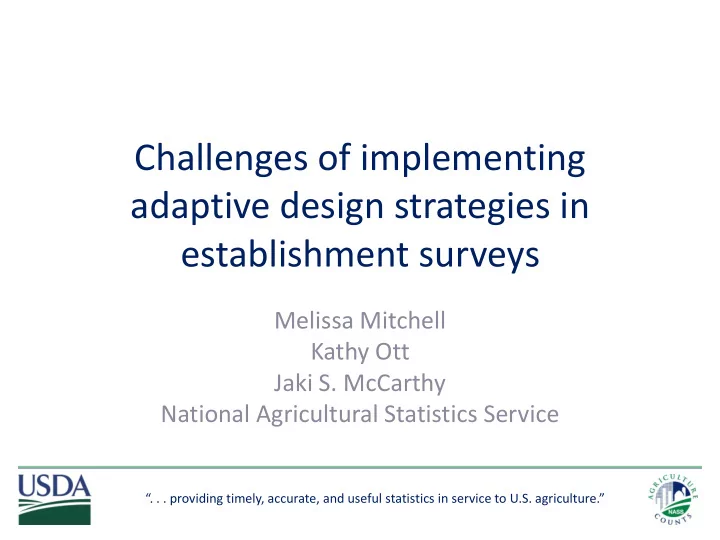

Challenges of implementing adaptive design strategies in establishment surveys Melissa Mitchell Kathy Ott Jaki S. McCarthy National Agricultural Statistics Service “. . . providing timely, accurate, and useful statistics in service to U.S. agriculture.”
Outline • Introduction – National Agricultural Statistics Service (NASS) – Summary of Agricultural Resource Management Survey (ARMS) • Method to proactively target non-respondents – Decision tree modeling • Adaptive Design Study • Lessons learned from implementing the study – Experiments in production settings – Issues with targeting high impact operations AAPOR May 16, 2014 2
National Agricultural Statistics Service (NASS) • Conduct surveys of farm operations – Establishment surveys • Survey topics including agricultural – Production – Economics – Demographics – Environment • Every five years NASS also conducts the Census of Agriculture AAPOR May 16, 2014 3
The Agricultural Resource Management Survey (ARMS) • Collects farm financial information and costs associated with producing agricultural commodities • Estimates at US, regional, and state level (for 15 states) • Lengthy annual survey with historically low response rates (in the 60% range) – 32 pages long – Over an hour to complete • Sample sizes typically >30k • Data collection primarily in person over approx. 3 months • Uses calibration weighting – Weights the respondent sample so estimated variable totals for a large set of items match “targets” determined from other sources AAPOR May 16, 2014 4
Nonresponse propensity models • Data mining approach – Census of Agriculture data were used as a proxy for ARMS data (both respondents and nonrespondents) – Classification tree models used to identify operations with greater than 70% likelihood of being a survey nonrespondent • These operations are typically large operations (i.e, capacity, production, acreage) AAPOR May 16, 2014 5
Impact Operations • NASS also wants to identify likely nonrespondent operations that are influential • These large operations may also be more critical than smaller operations to calibration weighting – Operations large relative to calibration targets are “impact operations” – Rank order from 1-3 • This talk will only discuss impact operations that are most important to calibration weighting AAPOR May 16, 2014 6
Adaptive Design Study • Split sample experiment – 441 operations in treatment group & 446 operations in control – Recall all of the operations in the study are likely nonrespondents • Manipulated data collection strategies – For operations in targeted/treatment group • Manipulated who goes to the operations based on impact score – For those most important to the calibration weighting » Initial in-person contact by field office director or other senior level staff » Data collection by experienced or supervisory interviewers » Interviewer incentives ($20) for hard cases – For operations in comparison/control group • Treat as you normally would AAPOR May 16, 2014 7
Overall ARMS Response Rates Likely Other Nonrespondents Complete 55.6% 73.1% Refusal 36.9% 21.8% Noncontacts 4.9% 4.2% Office Hold 2.9% 0.9% • Our models predicted nonresponse well AAPOR May 16, 2014 8
Response Rate for ARMS Study Targeted records Control records Complete 55.3% 55.2% Refusal 36.2% 37.5% Noncontact 4.8% 5.2% Office Hold 3.7% 2.1% • Our treatment did not improve response rates AAPOR May 16, 2014 9
Why didn’t our treatment work? • Debriefing with state offices – Procedures weren’t followed • 25% compliance for high impact – Procedures weren’t followed because of: » Field office reorganization; lack of available staff • “office staff were not available to contact in person” » Lack of funds » Some didn’t like the interviewer incentives • “Supervisors were in agreement that incentives are best used in recognition of the group, not the individual.” AAPOR May 16, 2014 10
What does this study reinforce? • Our models to identify likely nonrespondents work fairly well – How we harness & use this information is still an area of growth • Discussions currently ongoing – Change the focus of who we target with the nonresponse propensity scores? AAPOR May 16, 2014 11
Difficulty of experiments in production • Control versus treatment procedures – No one wants to adhere to control procedures that may make things worse – Not enough buy-in to the study • Lack of control (how implementation is carried out) – Directions not followed as anticipated (or at all) – Cannot monitor in real-time (only after-the fact) – No consequences to not following instructions • Progress is slow with testing in production – This survey is only done once a year; so we only get one chance to experiment with it before waiting an entire calendar year to try something else AAPOR May 16, 2014 12
Difficulty of targeting impact operations • These operations may already have special arrangements with the regional field offices – Currently, we are developing a program to formalize these special arrangements • No one wants to experiment with these cases in particular – Experimentation may have unanticipated consequences • These operations are just hard to get AAPOR May 16, 2014 13
Next steps • Adjustments made to our ARMS 2013 study – Work with smaller group of states • 12 states in 4 regional offices – Use the same procedures as 2012 study – Working closely with training and tracking the study in these states • More communication between research staff and field staff conducting field procedures • Already a sign of improvement: travel funds requested for a number of states (so they are requesting funds to send people out to the field) • Still in the field so we don’t have results yet AAPOR May 16, 2014 14
Where should we go from here? • More questions than answers – Should more effort be directed from hardest to get cases to those high impact operations predicted to be more likely to respond? – Should we re-examine our definition of impact operation? – What other data collection strategy can we employ? • Mode-switching • Letters • Incentives AAPOR May 16, 2014 15
Contact Info • Email: melissa.mitchell@nass.usda.gov • Phone: 703-877-8000 x 141 AAPOR May 16, 2014 16
Recommend
More recommend